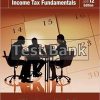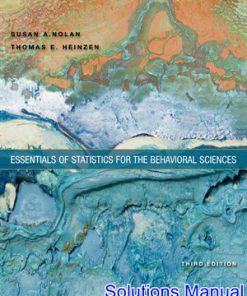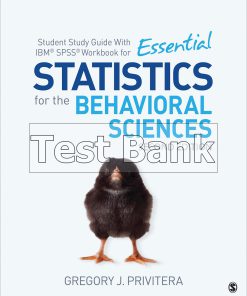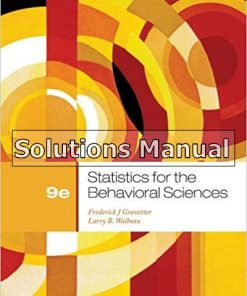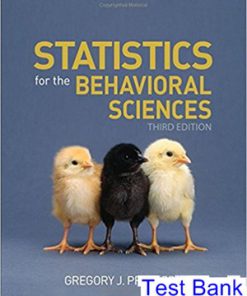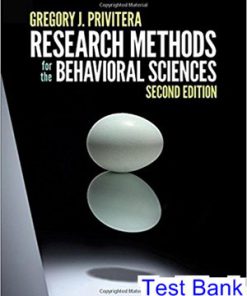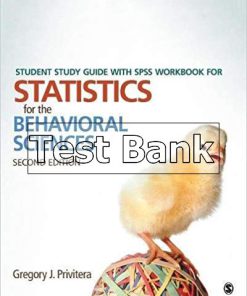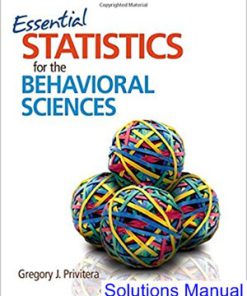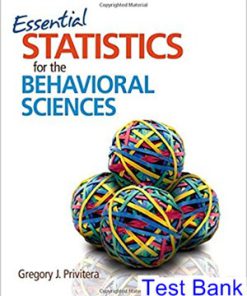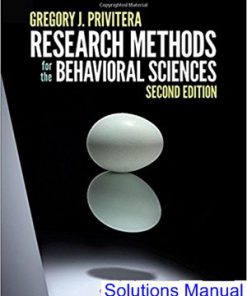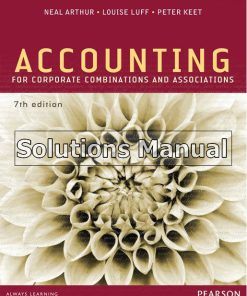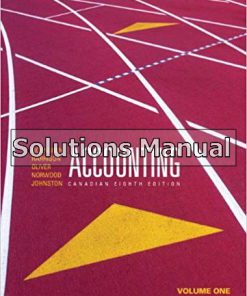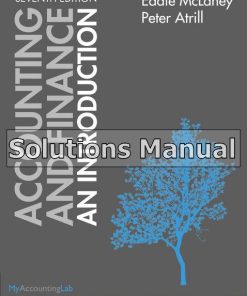Statistics for the Behavioral Sciences 3rd Edition Privitera Solutions Manual
$50.00 Original price was: $50.00.$26.50Current price is: $26.50.
Statistics for the Behavioral Sciences 3rd Edition Privitera Solutions Manual.
Statistics for the Behavioral Sciences 3rd Edition Privitera Solutions Manual
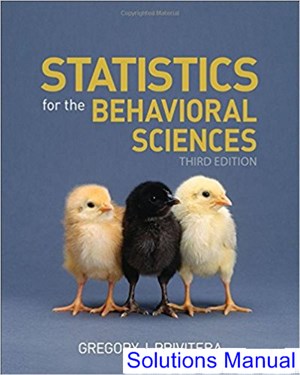
Product details:
- ISBN-10 : 154430224X
- ISBN-13 : 978-1544302249
- Author: Gregory J. Privitera
The engaging Third Edition of Statistics for the Behavioral Sciences shows students that statistics can be understandable, interesting, and relevant to their daily lives. Using a conversational tone, award-winning teacher and author Gregory J. Privitera speaks to the reader as researcher when covering statistical theory, computation, and application. Robust pedagogy allows students to continually check their comprehension and hone their skills when working through carefully developed problems and exercises that include current research and seamless integration of SPSS. This edition will not only prepare students to be lab-ready, but also give them the confidence to use statistics to summarize data and make decisions about behavior.
Table contents:
- Chapter 1: Introduction to Statistics
- 1.1: The Use of Statistics in Science
- 1.2: Descriptive and Inferential Statistics
- 1.3: Research Methods and Statistics
- 1.4: Scales of Measurement
- 1.5: Types of Variables for Which Data Are Measured
- 1.6: Research in Focus: Evaluating Data and Scales of Measurement
- 1.7: SPSS in Focus: Entering and Defining Variables
- 1: End-of-Chapter Problems (7)
- 1: Test Bank (36)
- Chapter 2: Summarizing Data: Frequency Distributions in Tables and Graphs
- 2.1: Why Summarize Data?
- 2.2: Frequency Distributions for Grouped Data
- 2.3: Identifying Percentile Points and Percentile Ranks
- 2.4: SPSS in Focus: Frequency Distributions for Quantitative Data
- 2.5: Frequency Distributions for Ungrouped Data
- 2.6: Research in Focus: Summarizing Demographic Information
- 2.7: SPSS in Focus: Frequency Distributions for Categorical Data
- 2.8: Pictorial Frequency Distributions
- 2.9: Graphing Distributions: Continuous Data
- 2.10: Graphing Distributions: Discrete and Categorical Data
- 2.11: Research in Focus: Frequencies and Percents
- 2.12: SPSS in Focus: Histograms, Bar Charts, and Pie Charts
- 2: End-of-Chapter Problems (14)
- 2: Test Bank (30)
- Chapter 3: Summarizing Data: Central Tendency
- 3.1: Introduction to Central Tendency
- 3.2: Measures of Central Tendency
- 3.3: Characteristics of the Mean
- 3.4: Choosing an Appropriate Measure of Central Tendency
- 3.5: Research in Focus: Describing Central Tendency
- 3.6: SPSS in Focus: Mean, Median, and Mode
- 3: End-of-Chapter Problems (18)
- 3: Test Bank (36)
- Chapter 4: Summarizing Data: Variability
- 4.1: Measuring Variability
- 4.2: The Range
- 4.3: Research in Focus: Reporting the Range
- 4.4: Quartiles and Interquartiles
- 4.5: The Variance
- 4.6: Explaining Variance for Populations and Samples
- 4.7: The Computational Formula for Variance
- 4.8: The Standard Deviation
- 4.9: What Does the Standard Deviation Tell Us?
- 4.10: Characteristics of the Standard Deviation
- 4.11: SPSS in Focus: Range, Variance, and Standard Deviation
- 4: End-of-Chapter Problems (13)
- 4: Test Bank (29)
- Chapter 5: Probability
- 5.1: Introduction to Probability
- 5.2: Calculating Probability
- 5.3: Probability and Relative Frequency
- 5.4: The Relationship Between Multiple Outcomes
- 5.5: Conditional Probabilities and Bayes’s Theorem
- 5.6: SPSS in Focus: Probability Tables
- 5.7: Probability Distributions
- 5.8: The Mean of a Probability Distribution and Expected Value
- 5.9: Research in Focus: When Are Risks Worth Taking?
- 5.10: The Variance and Standard Deviation of a Probability Distribution
- 5.11: Expected Value and the Binomial Distribution
- 5.12: A Final Thought on the Likelihood of Random Behavioral Outcomes
- 5: End-of-Chapter Problems (12)
- 5: Test Bank (30)
- Chapter 6: Probability, Normal Distributions, and z Scores
- 6.1: The Normal Distribution in Behavioral Science
- 6.2: Characteristics of the Normal Distribution
- 6.3: Research in Focus: The Statistical Norm
- 6.4: The Standard Normal Distribution
- 6.5: The Unit Normal Table: A Brief Introduction
- 6.6: Locating Proportions
- 6.7: Locating Scores
- 6.8: SPSS in Focus: Converting Raw Scores to Standard z Scores
- 6.9: Going From Binomial to Normal
- 6.10: The Normal Approximation to the Binomial Distribution
- 6: End-of-Chapter Problems (12)
- 6: Test Bank (29)
- Chapter 7: Probability and Sampling Distributions
- 7.1: Selecting Samples From Populations
- 7.2: Selecting a Sample: Who’s In and Who’s Out?
- 7.3: Sampling Distributions: The Mean
- 7.4: Sampling Distributions: The Variance
- 7.5: The Standard Error of the Mean
- 7.6: Factors That Decrease Standard Error
- 7.7: SPSS in Focus: Estimating the Standard Error of the Mean
- 7.8: APA in Focus: Reporting the Standard Error
- 7.9: Standard Normal Transformations With Sampling Distributions
- 7: End-of-Chapter Problems (11)
- 7: Test Bank (31)
- Chapter 8: Hypothesis Testing: Significance, Effect Size, and Power
- 8.1: Inferential Statistics and Hypothesis Testing
- 8.2: Four Steps to Hypothesis Testing
- 8.3: Hypothesis Testing and Sampling Distributions
- 8.4: Making a Decision: Types of Error
- 8.5: Testing for Significance: Examples Using the z Test
- 8.6: Research in Focus: Directional Versus Nondirectional Tests
- 8.7: Measuring the Size of an Effect: Cohen’s d
- 8.8: Effect Size, Power, and Sample Size
- 8.9: Additional Factors That Increase Power
- 8.10: SPSS in Focus: A Preview for Chapters 9 to 18
- 8.11: APA in Focus: Reporting the Test Statistic and Effect Size
- 8: End-of-Chapter Problems (12)
- 8: Test Bank (33)
- Chapter 9: Testing Means: One-Sample and Two-Independent-Sample t Tests
- 9.1: Going From z to t
- 9.2: The Degrees of Freedom
- 9.3: Reading the t Table
- 9.4: One-Sample t Test
- 9.5: Effect Size for the One-Sample t Test
- 9.6: SPSS in Focus: One-Sample t Test
- 9.7: Two-Independent-Sample t Test
- 9.8: Effect Size for the Two-Independent-Sample t Test
- 9.9: SPSS in Focus: Two-Independent-Sample t Test
- 9.10: APA in Focus: Reporting the t Statistic and Effect Size
- 9: End-of-Chapter Problems (13)
- 9: Test Bank (31)
- Chapter 10: Testing Means: The Related-Samples t Test
- 10.1: Related and Independent Samples
- 10.2: Introduction to the Related-Samples t Test
- 10.3: The Related-Samples t Test: Repeated-Measures Design
- 10.4: SPSS in Focus: The Related-Samples t Test
- 10.5: The Related-Samples t Test: Matched-Pairs Design
- 10.6: Measuring Effect Size for the Related-Samples t Test
- 10.7: Advantages for Selecting Related Samples
- 10.8: APA in Focus: Reporting the t Statistic and Effect Size for Related Samples
- 10: End-of-Chapter Problems (14)
- 10: Test Bank (31)
- Chapter 11: Estimation and Confidence Intervals
- 11.1: Point Estimation and Interval Estimation
- 11.2: The Process of Estimation
- 11.3: Estimation for the One-Sample z Test
- 11.4: Estimation for the One-Sample t Test
- 11.5: SPSS in Focus: Confidence Intervals for the One-Sample t Test
- 11.6: Estimation for the Two-Independent-Sample t Test
- 11.7: SPSS in Focus: Confidence Intervals for the Two-Independent-Sample t Test
- 11.8: Estimation for the Related-Samples t Test
- 11.9: SPSS in Focus: Confidence Intervals for the Related-Samples t Test
- 11.10: Characteristics of Estimation: Precisions and Certainty
- 11.11: APA in Focus: Reporting Confidence Intervals
- 11: End-of-Chapter Problems (13)
- 11: Test Bank (31)
- Chapter 12: Analysis of Variance: One-Way Between-Subjects Design
- 12.1: Analyzing Variance for Two or More Groups
- 12.2: An Introduction to Analysis of Variance
- 12.3: Sources of Variation and the Test Statistic
- 12.4: Degrees of Freedom
- 12.5: The One-Way Between-Subjects ANOVA
- 12.6: What Is the Next Step?
- 12.7: Post Hoc Comparisons
- 12.8: SPSS in Focus: The One-Way Between-Subjects ANOVA
- 12.9: Measuring Effect Size
- 12.10: APA in Focus: Reporting the F Statistic, Significance, and Effect Size
- 12: End-of-Chapter Problems (13)
- 12: Test Bank (29)
- Chapter 13: Analysis of Variance: One-Way Within-Subjects (Repeated-Measures) Design
- 13.1: Observing the Same Participants Across Groups
- 13.2: Sources of Variation and the Test Statistic
- 13.3: Degrees of Freedom
- 13.4: The One-Way Within-Subjects ANOVA
- 13.5: Post Hoc Comparisons: Bonferroni Procedure
- 13.6: SPSS in Focus: The One-Way Within-Subjects ANOVA
- 13.7: Measuring Effect Size
- 13.8: The Within-Subjects Design: Consistency and Power
- 13.9: APA in Focus: Reporting the F Statistic, Significance, and Effect Size
- 13: End-of-Chapter Problems (12)
- 13: Test Bank (31)
- Chapter 14: Analysis of Variance: Two-Way Between-Subjects Factorial Design
- 14.1: Observing Two Factors at the Same Time
- 14.2: New Terminology and Notation
- 14.3: Designs for the Two-Way ANOVA
- 14.4: Describing Variability: Main Effects and Interactions
- 14.5: The Two-Way Between-Subjects ANOVA
- 14.6: Analyzing Main Effects and Interactions
- 14.7: Measuring Effect Size
- 14.8: SPSS in Focus: The Two-Way Between-Subjects ANOVA
- 14.9: APA in Focus: Reporting Main Effects, Interactions, and Effect Size
- 14: End-of-Chapter Problems (15)
- 14: Test Bank (33)
- Chapter 15: Correlation
- 15.1: The Structure of a Correlational Design
- 15.2: Describing a Correlation
- 15.3: Pearson Correlation Coefficient
- 15.4: SPSS in Focus: Pearson Correlation Coefficient
- 15.5: Assumptions of Tests for Linear Correlations
- 15.6: Limitations in Interpretation: Causality, Outliers, and Restrictions of Range
- 15.7: Alternative to Pearson r: Spearman Correlation Coefficient
- 15.8: SPSS in Focus: Spearman Correlation Coefficient
- 15.9: Alternative to Pearson r: Point-Biserial Correlation Coefficient
- 15.10: SPSS in Focus: Point-Biserial Correlation Coefficient
- 15.11: Alternative to Pearson r: Phi Correlation Coefficient
- 15.12: SPSS in Focus: Phi Correlation Coefficient
- 15.13: APA in Focus: Reporting Correlations
- 15: End-of-Chapter Problems (12)
- 15: Test Bank (28)
- Chapter 16: Linear Regression and Multiple Regression
- 16.1: From Relationships to Predictions
- 16.2: Fundamentals of Linear Regression
- 16.3: What Makes the Regression Line the Best-Fitting Line?
- 16.4: The Slope and y-Intercept of a Straight Line
- 16.5: Using the Method of Least Squares to Find the Best Fit
- 16.6: Using Analysis of Regression to Determine Significance
- 16.7: SPSS in Focus: Analysis of Regression
- 16.8: Using the Standard Error of Estimate to Measure Accuracy
- 16.9: Introduction to Multiple Regression
- 16.10: Computing and Evaluating Significance for Multiple Regression
- 16.11: The β Coefficient for Multiple Regression
- 16.12: Evaluating Significance for the Relative Contribution of Each Predictor Variable
- 16.13: SPSS in Focus: Multiple Regression Analysis
- 16.14: APA in Focus: Reporting Regression Analysis
- 16: End-of-Chapter Problems (11)
- 16: Test Bank (29)
- Chapter 17: Nonparametric Tests: Chi-Square Tests
- 17.1: Tests for Nominal Data
- 17.2: The Chi-Square Goodness-of-Fit Test
- 17.3: SPSS in Focus: The Chi-Square Goodness-of-Fit Test
- 17.4: Interpreting the Chi-Square Goodness-of-Fit Test
- 17.5: Independent Observations and Expected Frequency Size
- 17.6: The Chi-Square Test for Independence
- 17.7: The Relationship Between Chi-Square and the Phi Coefficient
- 17.8: Measures of Effect Size
- 17.9: SPSS in Focus: The Chi-Square Test for Independence
- 17.10: APA in Focus: Reporting the Chi-Square Test
- 17: End-of-Chapter Problems (12)
- 17: Test Bank (30)
- Chapter 18: Nonparametric Tests: Tests for Ordinal Data
- 18.1: Tests for Ordinal Data
- 18.2: The Sign Test
- 18.3: SPSS in Focus: The Related-Samples Sign Test
- 18.4: The Wilcoxon Signed-Ranks T Test
- 18.5: SPSS in Focus: The Wilcoxon Signed-Ranks T Test
- 18.6: The Mann-Whitney U Test
- 18.7: SPSS in Focus: The Mann-Whitney U Test
- 18.8: The Kruskal-Wallis H Test
- 18.9: SPSS in Focus: The Kruskal-Wallis H Test
- 18.10: The Friedman Test
- 18.11: SPSS in Focus: The Friedman Test
- 18.12: APA in Focus: Reporting Nonparametric Tests
- 18: End-of-Chapter Problems (12)
- 18: Test Bank (32)
People also search:
statistics for the behavioral sciences 3rd edition
statistics for the behavioral sciences 3rd edition pdf
statistics for the behavioral sciences 3rd edition privitera
statistics for the behavioral sciences 3rd edition privitera pdf free
what is behavioral science statistics
Instant download after Payment is complete
You may also like…
Related products
Solutions Manual
Solutions Manual
Accounting Principles 13th Edition Weygandt Solutions Manual
Solutions Manual
Solutions Manual
Solutions Manual
Accounting Information Systems 10th Edition Hall Solutions Manual
Solutions Manual
Accounting Volume 1 Canadian 8th Edition Horngren Solutions Manual


